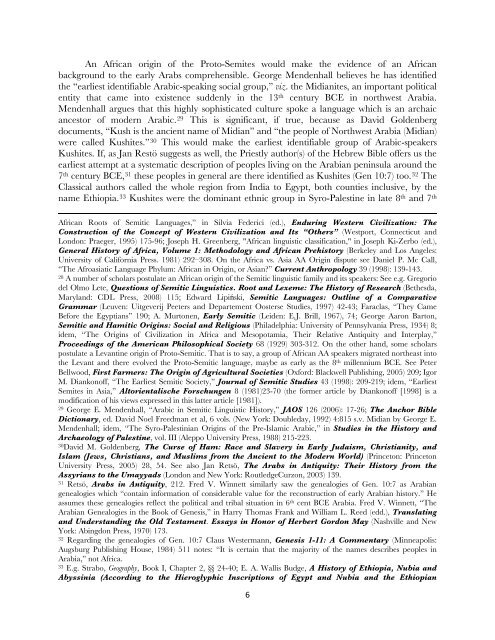“Anyone who says that the Prophet is black should be killed”: The ...
“Anyone who says that the Prophet is black should be killed”: The ...
“Anyone who says that the Prophet is black should be killed”: The ...
Create successful ePaper yourself
Turn your PDF publications into a flip-book with our unique Google optimized e-Paper software.
An African origin of <strong>the</strong> Proto-Semites would make <strong>the</strong> evidence of an African<br />
background to <strong>the</strong> early Arabs comprehensible. George Mendenhall <strong>be</strong>lieves he has identified<br />
<strong>the</strong> “earliest identifiable Arabic-speaking social group,” viz. <strong>the</strong> Midianites, an important political<br />
entity <strong>that</strong> came into ex<strong>is</strong>tence suddenly in <strong>the</strong> 13th century BCE in northwest Arabia.<br />
Mendenhall argues <strong>that</strong> th<strong>is</strong> highly soph<strong>is</strong>ticated culture spoke a language which <strong>is</strong> an archaic<br />
ancestor of modern Arabic. 29 Th<strong>is</strong> <strong>is</strong> significant, if true, <strong>be</strong>cause as David Golden<strong>be</strong>rg<br />
documents, “Kush <strong>is</strong> <strong>the</strong> ancient name of Midian” and “<strong>the</strong> people of Northwest Arabia (Midian)<br />
were called Kushites.” 30 Th<strong>is</strong> would make <strong>the</strong> earliest identifiable group of Arabic-speakers<br />
Kushites. If, as Jan Restö suggests as well, <strong>the</strong> Priestly author(s) of <strong>the</strong> Hebrew Bible offers us <strong>the</strong><br />
earliest attempt at a systematic description of peoples living on <strong>the</strong> Arabian peninsula around <strong>the</strong><br />
7th century BCE, 31 <strong>the</strong>se peoples in general are <strong>the</strong>re identified as Kushites (Gen 10:7) too. 32 <strong>The</strong><br />
Classical authors called <strong>the</strong> <strong>who</strong>le region from India to Egypt, both counties inclusive, by <strong>the</strong><br />
name Ethiopia. 33 Kushites were <strong>the</strong> dominant ethnic group in Syro-Palestine in late 8th and 7th African Roots of Semitic Languages,” in Silvia Federici (ed.), Enduring Western Civilization: <strong>The</strong><br />
Construction of <strong>the</strong> Concept of Western Civilization and Its “O<strong>the</strong>rs” (Westport, Connecticut and<br />
London: Praeger, 1995) 175-96; Joseph H. Green<strong>be</strong>rg, "African lingu<strong>is</strong>tic classification," in Joseph Ki-Zerbo (ed.),<br />
General H<strong>is</strong>tory of Africa, Volume 1: Methodology and African Preh<strong>is</strong>tory (Berkeley and Los Angeles:<br />
University of California Press. 1981) 292–308. On <strong>the</strong> Africa vs. Asia AA Origin d<strong>is</strong>pute see Daniel P. Mc Call,<br />
“<strong>The</strong> Afroasiatic Language Phylum: African in Origin, or Asian?” Current Anthropology 39 (1998): 139-143.<br />
28 A num<strong>be</strong>r of scholars postulate an African origin of <strong>the</strong> Semitic lingu<strong>is</strong>tic family and its speakers: See e.g. Gregorio<br />
del Olmo Lete, Questions of Semitic Lingu<strong>is</strong>tics. Root and Lexeme: <strong>The</strong> H<strong>is</strong>tory of Research (Be<strong>the</strong>sda,<br />
Maryland: CDL Press, 2008) 115; Edward Lipiński, Semitic Languages: Outline of a Comparative<br />
Grammar (Leuven: Uitgeverij Peeters and Departement Oosterse Studies, 1997) 42-43; Faraclas, “<strong>The</strong>y Came<br />
Before <strong>the</strong> Egyptians” 190; A. Murtonen, Early Semitic (Leiden: E.J. Brill, 1967), 74; George Aaron Barton,<br />
Semitic and Hamitic Origins: Social and Religious (Philadelphia: University of Pennsylvania Press, 1934) 8;<br />
idem, “<strong>The</strong> Origins of Civilization in Africa and Mesopotamia, <strong>The</strong>ir Relative Antiquity and Interplay,”<br />
Proceedings of <strong>the</strong> American Philosophical Society 68 (1929) 303-312. On <strong>the</strong> o<strong>the</strong>r hand, some scholars<br />
postulate a Levantine origin of Proto-Semitic. That <strong>is</strong> to say, a group of African AA speakers migrated nor<strong>the</strong>ast into<br />
<strong>the</strong> Levant and <strong>the</strong>re evolved <strong>the</strong> Proto-Semitic language, may<strong>be</strong> as early as <strong>the</strong> 8 th millennium BCE. See Peter<br />
Bellwood, First Farmers: <strong>The</strong> Origin of Agricultural Societies (Oxford: Blackwell Publ<strong>is</strong>hing, 2005) 209; Igor<br />
M. Diankonoff, “<strong>The</strong> Earliest Semitic Society,” Journal of Semitic Studies 43 (1998): 209-219; idem, “Earliest<br />
Semites in Asia,” Altoriental<strong>is</strong>che Forschungen 8 (1981)23-70 (<strong>the</strong> former article by Diankonoff [1998] <strong>is</strong> a<br />
modification of h<strong>is</strong> views expressed in th<strong>is</strong> latter article [1981]).<br />
29 George E. Mendenhall, “Arabic in Semitic Lingu<strong>is</strong>tic H<strong>is</strong>tory,” JAOS 126 (2006): 17-26; <strong>The</strong> Anchor Bible<br />
Dictionary, ed. David Noel Freedman et al, 6 vols. (New York: Doubleday, 1992) 4:815 s.v. Midian by George E.<br />
Mendenhall; idem, “<strong>The</strong> Syro-Palestinian Origins of <strong>the</strong> Pre-Islamic Arabic,” in Studies in <strong>the</strong> H<strong>is</strong>tory and<br />
Archaeology of Palestine, vol. III (Aleppo University Press, 1988) 215-223.<br />
30 David M. Golden<strong>be</strong>rg, <strong>The</strong> Curse of Ham: Race and Slavery in Early Juda<strong>is</strong>m, Chr<strong>is</strong>tianity, and<br />
Islam (Jews, Chr<strong>is</strong>tians, and Muslims from <strong>the</strong> Ancient to <strong>the</strong> Modern World) (Princeton: Princeton<br />
University Press, 2005) 28, 54. See also Jan Retsö, <strong>The</strong> Arabs in Antiquity: <strong>The</strong>ir H<strong>is</strong>tory from <strong>the</strong><br />
Assyrians to <strong>the</strong> Umayyads (London and New York: RoutledgeCurzon, 2003) 139.<br />
31 Retsö, Arabs in Antiquity, 212. Fred V. Winnett similarly saw <strong>the</strong> genealogies of Gen. 10:7 as Arabian<br />
genealogies which “contain information of considerable value for <strong>the</strong> reconstruction of early Arabian h<strong>is</strong>tory.” He<br />
assumes <strong>the</strong>se genealogies reflect <strong>the</strong> political and tribal situation in 6 th cent BCE Arabia. Fred V. Winnett, “<strong>The</strong><br />
Arabian Genealogies in <strong>the</strong> Book of Genes<strong>is</strong>,” in Harry Thomas Frank and William L. Reed (edd.), Translating<br />
and Understanding <strong>the</strong> Old Testament. Es<strong>says</strong> in Honor of Her<strong>be</strong>rt Gordon May (Nashville and New<br />
York: Abingdon Press, 1970) 173.<br />
32 Regarding <strong>the</strong> genealogies of Gen. 10:7 Claus Westermann, Genes<strong>is</strong> 1-11: A Commentary (Minneapol<strong>is</strong>:<br />
Augsburg Publ<strong>is</strong>hing House, 1984) 511 notes: “It <strong>is</strong> certain <strong>that</strong> <strong>the</strong> majority of <strong>the</strong> names descri<strong>be</strong>s peoples in<br />
Arabia,” not Africa.<br />
33 E.g. Strabo, Geography, Book I, Chapter 2, §§ 24-40; E. A. Wall<strong>is</strong> Budge, A H<strong>is</strong>tory of Ethiopia, Nubia and<br />
Abyssinia (According to <strong>the</strong> Hieroglyphic Inscriptions of Egypt and Nubia and <strong>the</strong> Ethiopian<br />
6
















